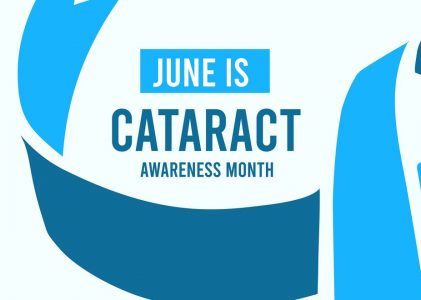What is a Cataract?

Cataract affects more than twenty-five million Americans and are the primary cause of blindness in 42% of all cases worldwide, according to PreventBlindness.org. This is an alarming statistic. A cataract is a cloudiness that develops in the eye’s lens, which is usually clear and is located behind the pupil and iris, the colored part of the eye. This clouding affects the passage of light into the eye, thus obstructing the proper passage of light to the retina located on the back of the eye. The retina transmits images to the brain, so if the lens cannot focus images onto the retina, the result can be blurry or obstructed vision.
Most cataracts occur with age, with almost half of Americans suffering from cataracts by the age of 80. Other risk factors include:
- Eye injuries
- Eye diseases
- Inflammation in the eye
- Certain diseases, for example, diabetes
- Smoking
- Long-term exposure to the sun’s harmful UV rays
- Long-term steroid use
- Heredity influences
Symptoms of Cataracts
Typically, a cataract does not cause any tears, redness, or pain. But the following symptoms are signs that would indicate you may have a cataract:
- Blurred vision or double vision, typically in one eye
- You are bothered by bright light or light that seems too dim for reading or “close-up” work
- The need to change your eye prescription often, but it does not seem to help with vision
- The ability to see the cataract in your pupil, which appears as a yellow or milky white spot
- Difficulty seeing at night
- Seeing a “halo” around light
At first, the cloudiness in your vision from cataracts may be so small that you do not notice any vision changes. As the cataract gets larger, your vision can become blurry, or you may experience double vision.
Types of Cataracts
There are several distinct types of cataracts, which include:
Cortical Cataracts: These are cataracts that affect the edges of the eye’s lens. They begin as whitish streaks or opacities on the lens cortex’s outer edge. During its progression, the streaks begin to obstruct light as they extend to the center of the lens.
Congenital Cataracts: This type of cataract is one you are born with. There are people with a genetic disposition to cataracts and are born with them, or they develop during childhood due to intrauterine infection or trauma. In addition, certain conditions such as galactosemia, myotonic dystrophy, neurofibromatosis type 2, or rubella can cause cataracts.
Nuclear Cataracts: These cataracts affect the center of the lens and cause more nearsightedness or a temporary improvement in reading vision. Over time, as the cataract grows, the lens turns densely yellow, causing more clouds in your vision. Nuclear cataracts can also cause difficulty distinguishing between shades of color due to advanced yellowing or browning of the lens.
Posterior Subcapsular Cataracts: This type of cataract affects the back of the eye’s lens. It starts as a small, opaque area near the back of the lens and often affects your reading vision, causing glare or halos around lights at night and reduced vision in bright light. Posterior subcapsular cataracts progress faster than other types of cataracts.
You can find more information about the different types of cataracts at the Mayo Clinic.
If you are noticing a change in your vision, make an appointment to meet with your eye doctor right away. Your eye doctor will go over your medical history, assess your symptoms, and perform an eye exam to determine if you have a cataract or another eye disease. Only your eye doctor can tell you for sure if you have a cataract and determine what treatment option is best for you.
Cataract Surgery Treatment
If your cataract is impairing your vision and causing difficulty treating other eye problems, your doctor may recommend cataract surgery. If your vision is still good even with a cataract, you may choose not to have eye surgery right away. But, if your cataract is affecting your ability to perform normal daily tasks or work tasks, cataract surgery may be the best option for you.
Your eye doctor can speak with you about the best treatment option for you and the associated risks.
Prevention of Cataracts
The best way to detect cataracts is to have regular eye exams with your eye doctor and discuss your risk factors. If you notice a change in your vision, make an appointment with your eye doctor right away. Studies have not shown how to prevent cataracts entirely, but doctors believe certain strategies may be helpful, including:
- Schedule regular eye examinations with your eye doctor
- Quit smoking
- Manage other health problems, such as diabetes
- Choose a healthy diet rich in fruits and vegetables
- Reduce alcohol use
- Wear sunglasses
GWIC offers Ophthalmic MRI services to help diagnose and treat eye conditions and diseases.
Financial Assistance for Eye Health
There are a variety of financial assistance programs and resources to help with your eye health needs. Certain insurance coverage may help with the cost of cataract screening and treatment, and PreventBlindness.org offers several resources that can assist you with financial assistance for vision care. Greater Waterbury Imaging Center cares about your eye health and urges everyone to see their eye doctor regularly. Scheduling regular eye exams is the best way to help prevent and manage your risk for cataracts.
Contact us to receive exceptional, professional service for all your MR imaging needs, including Ophthalmic MR imaging services.


